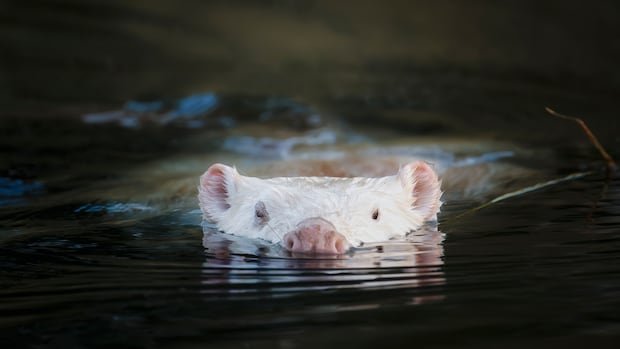On a serene evening in autumn near Perth, Ontario, a group of nature photographers quietly pursued their elusive subject on a river. Using an electric trolling motor for propulsion, the water remained calm as they moved upstream. Suddenly, a loud splash broke the silence as the target, a mythical white beaver, sensed their presence and swiftly disappeared beneath the water’s surface.
Dennis Jackson, an Ottawa photographer with a passion for wildlife photography, found himself face-to-face with this rare white beaver, a sight he never expected despite his extensive experience in capturing images of animals. Following a previous sighting during a boat trip with his neighbor, Jackson eagerly returned to the river accompanied by acclaimed Canadian naturalist Michael Runtz, his wife Britta Runtz – also a professional photographer, and a reporter from CBC.
Aside from hoping for another glimpse of the white beaver, Jackson sought to unravel a mystery: Was this unique beaver an albino, a rare survival tale given that most albino animals suffer from poor eyesight, or was it leucistic, a condition resulting in partial loss of pigmentation?
During the dusk hours, the white beaver reappeared, but upon detecting the human presence, its intentions remained uncertain. With anticipation high, the photographers observed as the white beaver swam underwater past their boat, its pale tail flashing, before emerging near a cluster of reeds. The creature then ventured onto land, revealing a dark fur patch on its front left paw and distinctly dark eyes.
Runtz, the retired Carleton University professor, marveled at the sight, deducing, “With true albinism, you can’t produce any dark pigmentation, so the eyes are always pink, so I would say that’s a leucistic beaver.”
The group was thrilled to have captured photographic evidence of this remarkable encounter. Runtz expressed his satisfaction, stating, “I’m very happy just seeing it, if I didn’t get any photographs I’d be almost equally as happy. But I must admit I am a little happier that we were successful in getting pictures, too.”
While color mutations in beavers are not uncommon, lighter coats can make them more vulnerable to predators. The rarity of white beavers is evident as the Canadian Museum of Nature possesses a leucistic beaver pelt collected in 1918 in Rainy River, Ontario.
Dominique Fauteux, a research scientist at the museum specializing in mammalogy, highlighted the scarcity of white beavers, suggesting that this unique mutation has not been evolutionarily advantageous over time. Despite the scientific implications, Jackson was more captivated by the singular nature of the sighting, declaring it as one of the most extraordinary experiences he had witnessed as he guided the boat back home.


